There are a few reasons snakes can be frightening. They’re muscular and legless, and some species’ constricting abilities can make people’s skin crawl. Some others find snakes fascinating. You’re curious about the mysteries around snake sizes.
When most people think of pet snakes, they envision fearsome cobras, massive anacondas, and pythons. They are a good pet, but you don’t want one that is difficult to care for or is extremely large.
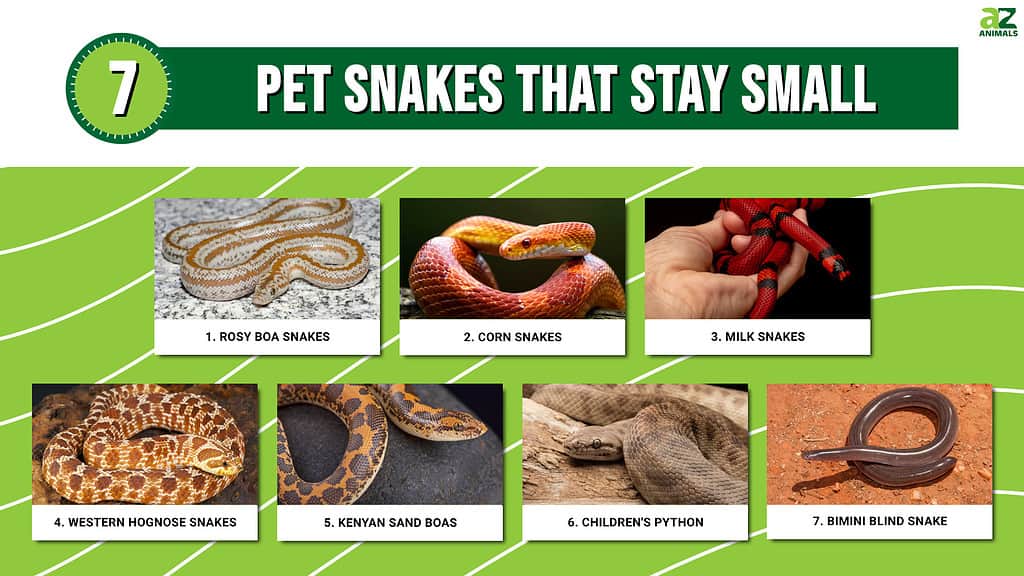
Snakes that are kept small make excellent pets. You can see snakes that stay small forever, teach you responsibility, and are easy to care for. Hence, continue reading this article to get an insight into the pet snakes that stay small forever.
Characteristics Of A Good Beginner Snake
The following criteria will help you identify a species as a good starter snake:
- Availability (can the species be found easily?)
- The snake’s overall size and ease of handling (temperament)
- The snake’s feeding response (those that accept thawed or frozen prey or even non-whole food like eggs and meat).
The last characteristic is crucial because dealing with a snake that refuses to eat can be stressful and requires some experience to resolve. Regardless of the species, your best approach to keeping a pet snake is to buy snakes that are not too young.
Another thing you can do is to confirm with the dealer that the snake is feeding on frozen prey to assess its feeding response. You can keep all the snakes on this list in 30-gallon tanks or smaller.
Small Pet Snakes That Stay Small
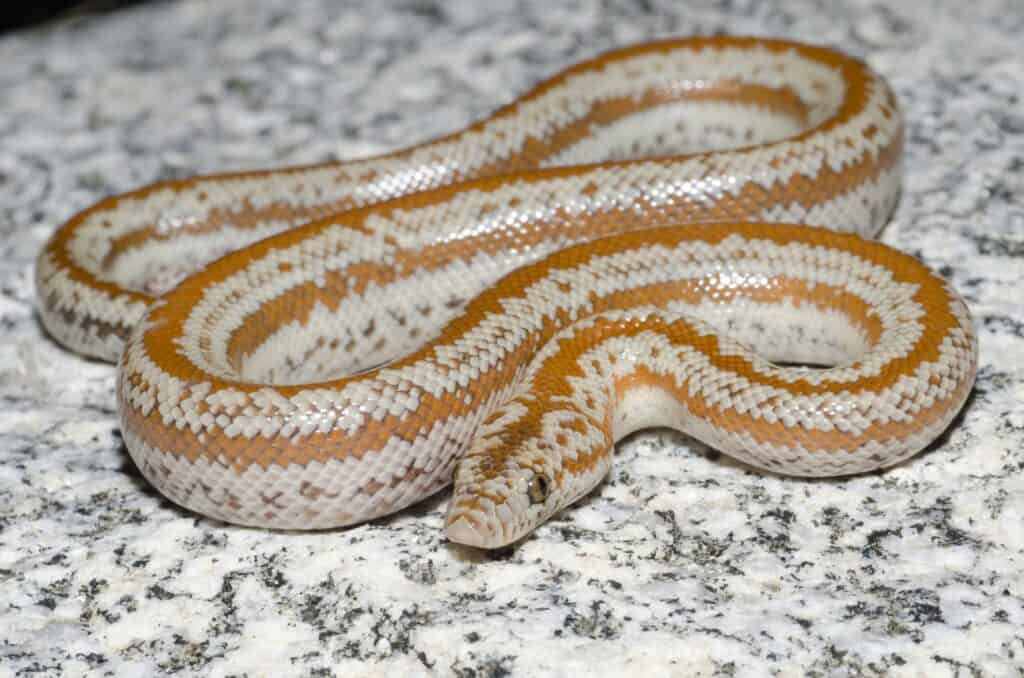
Rosy Boa’s are gentle, low-maintenance snakes.
©Jason Mintzer/Shutterstock.com
1. Rosy Boa
Size: 18 – 46 inches
Temperament: gentle, docile
Availability: snake dealers, reptile shows, and online shops.
Feeding Response: some picky eaters may require a brumation period for optimal feeding response.
Rosy Boa snakes in Latin as “trivirgata,” which implies “three stripes.” Most of them have three-colored stripes running down their bodies: brown, orange, and black. However, depending on where you live, you can still find them in other morphs.
Rosy Boas are lovely little snakes that need little attention aside from keeping their temperatures stable. They have thick bodies and cannot grow taller than three feet. You can keep some of them in tanks as small as 10 gallons, but the general recommendation is 15 to 20 gallons.
Unfortunately, the high humidity in their habitat can lead to fungal and respiratory problems, but they can live for up to 25 years. So, ensure you care for your pet snake for the rest of its life.
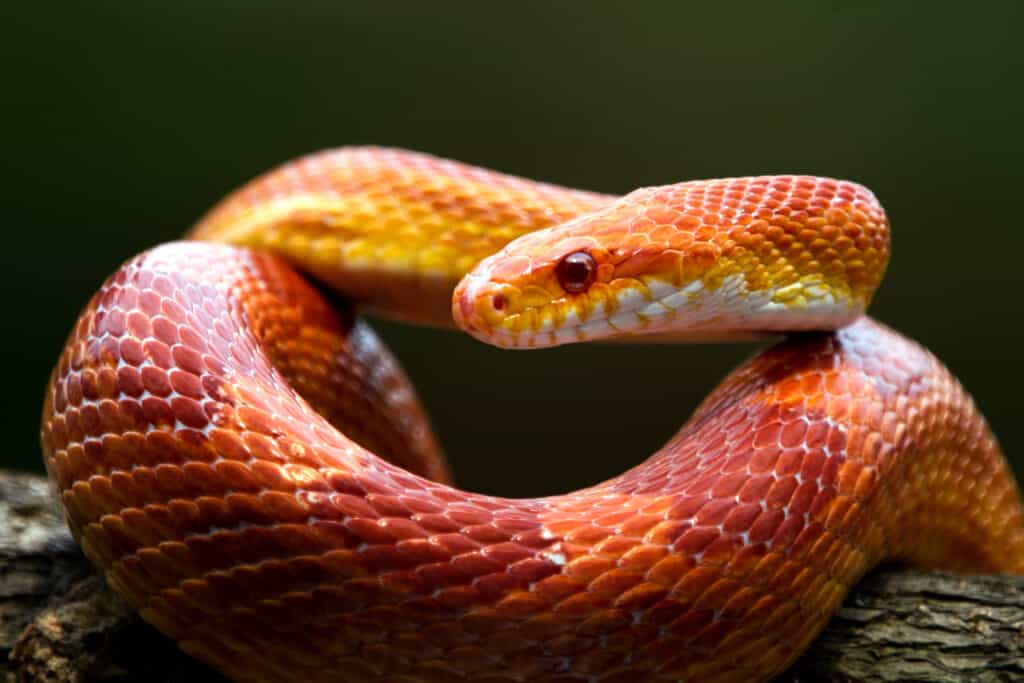
Corn snakes are some of the most common pet snakes. They are docile, slow-moving, and come in various colors.
©Kurit afshen/Shutterstock.com
2. Corn Snakes
Size: 2 – 6 feet
Temperament: docile, but the young ones can be erratic.
Availability: commonly seen.
Feeding Response: the older snakes usually have a good feeding response.
Corn snakes are among the most common small pet snakes, particularly among new snake keepers. They have a lot of advantages as they are easy-going and reasonably sized. Selective breeding allows experts to breed these snakes to almost any color you want, though they are naturally orange.
Corn snakes are slow-moving ground snakes that enjoy burrowing. They also come in various colors and are selectively bred morphs. These small pets are inexpensive, simple to care for, and rarely have feeding issues in captivity.
Corn snakes require a thawed or frozen rodent diet but rarely refuse food in captivity. Many of them eat raw chicken from the package. They are docile, hardy, and rarely develop feeding issues.
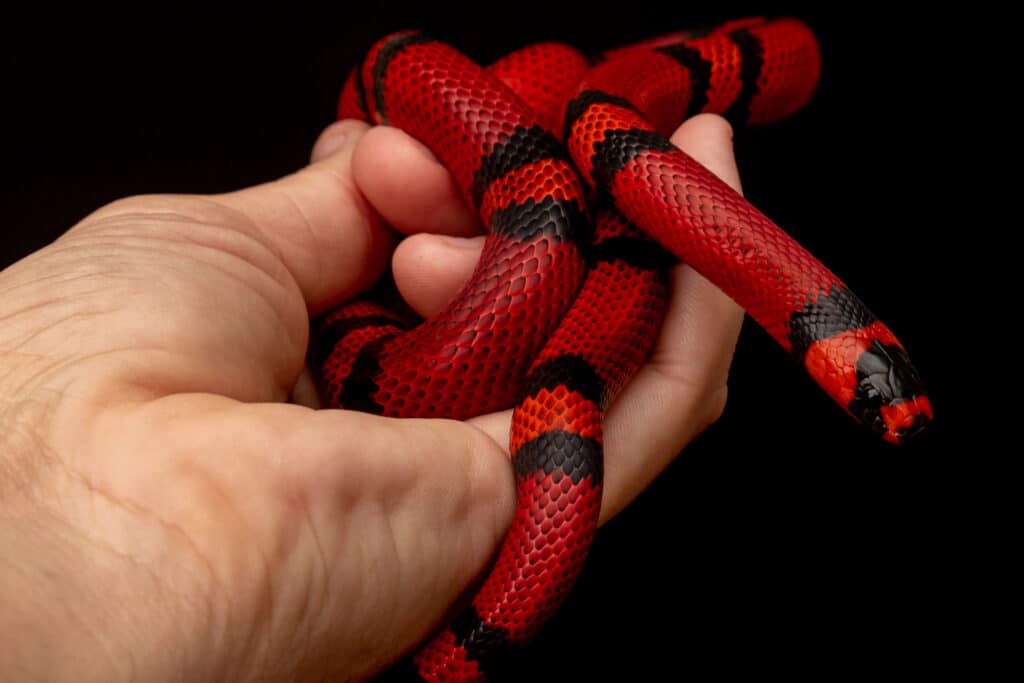
Milk snakes are generally calm, but some may bite if startled.
©Murilo Mazzo/Shutterstock.com
3. Milk Snakes
Size: 14–48 inches
Availability: commonly seen.
Temperament: calm, but some are flighty and may bite.
Feeding Response: Moderate. Some are incredibly picky. Just ensure they are feeding properly.
Milk snakes are a small kingsnake species found throughout North, Central, and Central America. They belong to the Lampropeltis genus, with 24 subspecies recognized. The New Mexico Milk Snake is one of the smallest species, reaching a maximum length of about 18 inches.
Because of their ease of care and stunning colors, this species has been known in captivity since the 1970s. Their black, red, and white or yellow bands mimic the venomous coral snake to ward off predators.
Milk snakes are not dangerous. Each subspecies requires slightly different care, so if you choose this species.
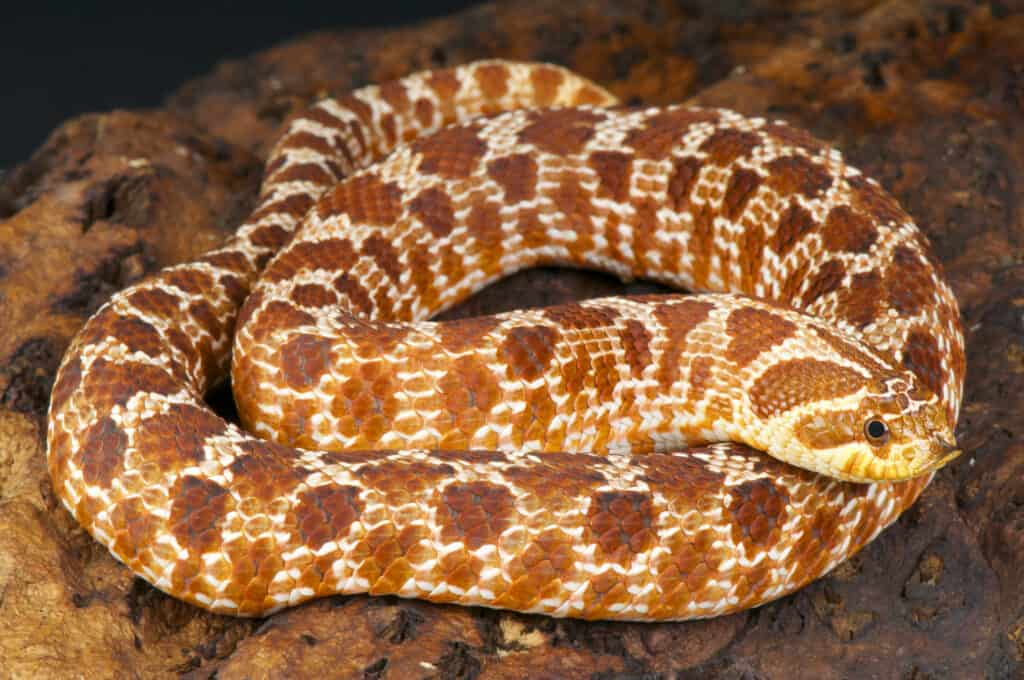
When threatened, the Western Hognose may emit a foul odor. However, it’s unlikely for those in captivity to feel this way.
©reptiles4all/Shutterstock.com
4. Western Hognose
Sizes: 14 – 36 inches (females are larger)
Availability: widespread
Temperament: docile.
Feeding Response: Excellent
Western hognose snakes are distinct in appearance, with stout bodies and upturned snouts. They also exhibit intriguing behaviors. When threatened, they exhibit unusual bluffing behavior like hissing, flattening their bodies, and even playing dead as a last-ditch effort.
Defensive hognose snakes may secrete a foul-smelling musk or strike at their opponent with their mouth closed. With their easy-going nature, captive-bred snakes rarely feel the need to put on these defensive displays. They also rarely bite.
The popularity of this species has grown over time because of their distinct facial features and adorable sizes. These snakes are easy to care for and can be kept in a small, low-cost enclosure (20-gallon tank or plastic bin). However, they require additional lighting.
Western Hognose snakes feed on amphibians and toads when not kept in captivity. They are suitable for new keepers. In captivity, the diet makes it challenging to pique the interest of a neonate Western Hognose in mice. They can, however, become accustomed to it with timers.
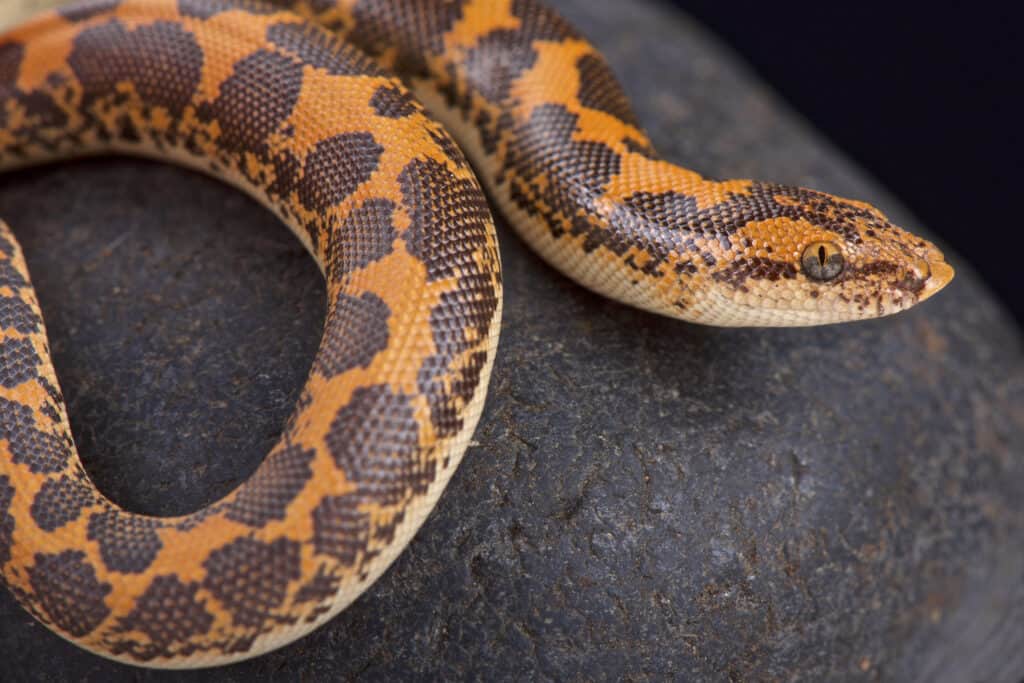
Kenyan Sand Boa’s are usually docile, but may bite your hand if they mistake it for food.
©reptiles4all/Shutterstock.com
5. Kenyan Sand Boa
Size: 20 – 34 inches
Temperament: some may be flighty.
Availability: commonly seen.
Feeding Response: Baby snakes frequently require live feeding. Hence, purchase older snakes that have been confirmed to feed well.
Kenyan Sand Boas are ideal for those looking for a small snake in both girth and length. They originate from Northern Africa, and their name suggests they enjoy burrowing in the sand. They are colorful and can be comfortably housed in a tank as small as 10 gallons or a similarly sized plastic tub.
Their habitats also need few decorations, only a few substrates such as coconut mulch, calcium, aspen, and play sand into which they can burrow.
Most Kenyan sand boas have a docile temperament, though some can be flighty. However, they do not bite in defense. Bites can only occur if the snake misidentifies your hand as food.
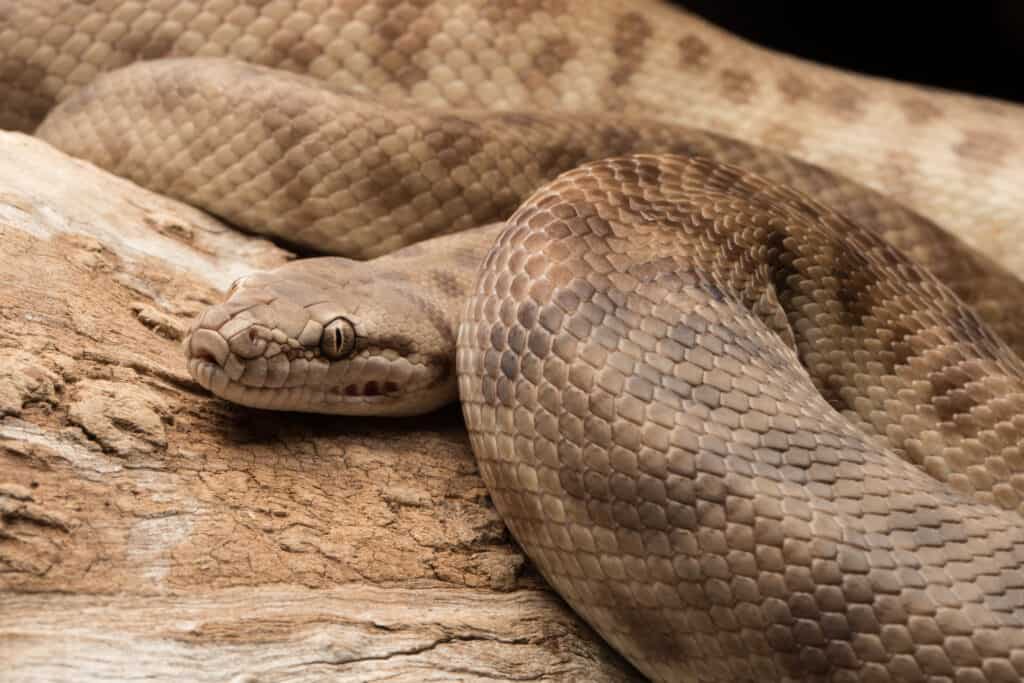
Children’s pythons can be picky when young. They feed primarily on frogs and mice as adults.
©LIGHTITUP/Shutterstock.com
6. Children’s Python
Size: 30–36 inches (2.5 feet is the most common)
Temperament: as babies, they are a little feisty. As adults, they are docile.
Availability: snake dealers.
Feeding Response: Moderate. Adults should eat thawed or frozen mice.
Children’s python may be unfamiliar to you, but it is among the most popular small pet snakes in pet stores. The name doesn’t suggest it’s for children; instead, they were named after scientist John George Children.
These Australian snake species are larger than small snakes and make excellent companions for new keepers. However, young Children’s pythons are tricky for beginners to raise. You should consider an adult species.
These miniature animals will fit in a 15-gallon tank, but two snakes will fit in a 20-gallon tank. They feed primarily on frogs and lizards in the wild. Hence, like most snakes, they are naturally picky when young. Almost all available Children’s pythons will be fed thawed or frozen mice.
This snake has a flat pattern with little contrast. It has a tan background with irregular brown spots down its back. Because these spots are only a couple of shades darker, they don’t stand out.

©Ken Griffiths/Shutterstock.com
7. Bimini Blind Snake
Size: 4 – 6 inches
Temperament: drab and docile.
Availability: snake dealers.
Feeding Response: moderate.
The Bimini Blind snake looks like an earthworm. It was native to Africa before being introduced to the Americas. They are not the most involved or interactive pet reptiles, but their size makes them popular in the world of pets.
It is also known as the common blind snake, the Hawaiian blind snake, the island blind snake, and the flowerpot snake. It has a shiny body with no visible scales and is much thinner than long.
Even though their name includes “blind,” Bimini blind snakes are not blind. It’s just that their eyes are too tiny to see. The longest blind snake can reach 6 inches.
Why Might a Small Pet Snake Be Right for You?
Low-Cost Maintenance
Although the price of a pet snake varies depending on the species, you may spend a fortune on the smallest of all. Small snakes don’t eat as much as giant snakes, so you’ll spend less money on food. It will exempt you from the extra costs of decorations, enclosures, and heating elements.
No Danger Of Injury
Small snakes are usually docile and incapable of inflicting serious harm. The snakes’ sizes prevent them from constricting humans or other animals to death; they will not injure you. Furthermore, you will not strain a muscle handling small snakes like larger ones. The worst-case scenario is a minor love bite.
No Allergies
Because snakes do not shed like other pets, you won’t have to worry about sneezing fits or excessive cleaning. These reptiles have no odor because they are easy to clean.
Conclusion
Snakes often receive negative reactions from most people, but they actually make great companion pets. A small pet snake is a splendid choice if you need a companion who requires only basic care.
Bonus: What is the Most Difficult Snake to Keep as a Pet?
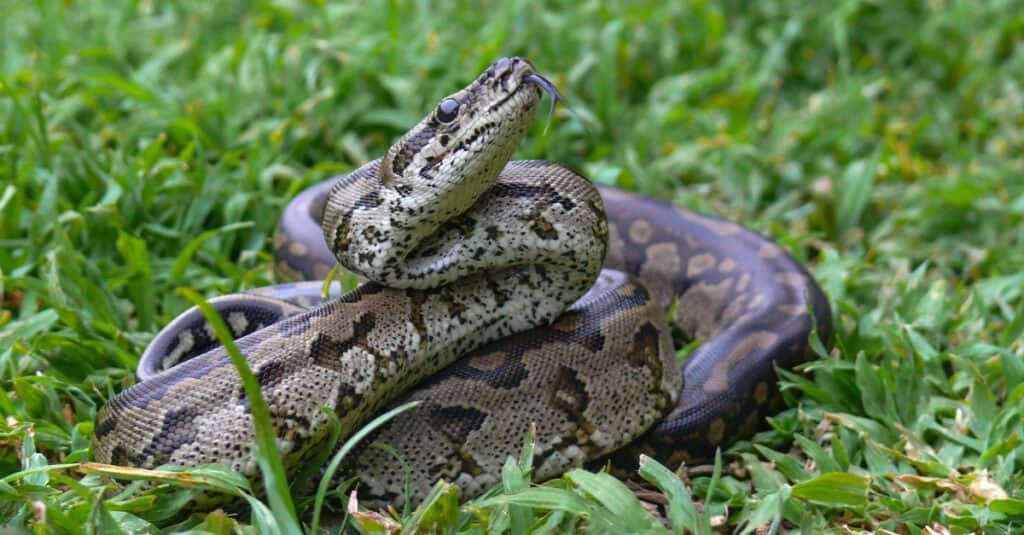
African rock pythons are aggressive, large, and require large animals for food.
©Chris Graf/Shutterstock.com
The seven snakes covered in this article all make great pets for beginners and experienced snake lovers alike. Some snakes do not make great pets – and the one that is considered to be the most difficult is the African rock python. These snakes can reach lengths of 20 feet or more and require appropriately large food – such as chickens and rabbits. They are irritable and aggressive and would be a scary pet in an extra-large enclosure that would have to be extremely secure to prevent escape.
Summary of 7 Pet Snakes That Stay Small
| Snake | Size | Temperament | |
|---|---|---|---|
| 1 | Rosy Boa | 18 – 46 inches | Gentle, docile |
| 2 | Corn Snakes | 2 – 6 feet | Docile, young snakes are more erratic |
| 3 | Milk Snakes | 14 – 48 inches | Calm, but some are flighty and may bite |
| 4 | Western Hognose | 14 – 36 inches | Docile |
| 5 | Kenyan Sand Boa | 20 – 34 inches | Some are flighty |
| 6 | Children’s Python | 30 – 36 inches | Docile adults, babies are feisty |
| 7 | Bimini Blind Snake | 4 – 6 inches | Docile |
The photo featured at the top of this post is © Egoreichenkov Evgenii/Shutterstock.com
Discover the "Monster" Snake 5X Bigger than an Anaconda
Every day A-Z Animals sends out some of the most incredible facts in the world from our free newsletter. Want to discover the 10 most beautiful snakes in the world, a "snake island" where you're never more than 3 feet from danger, or a "monster" snake 5X larger than an anaconda? Then sign up right now and you'll start receiving our daily newsletter absolutely free.
Thank you for reading! Have some feedback for us? Contact the AZ Animals editorial team.






